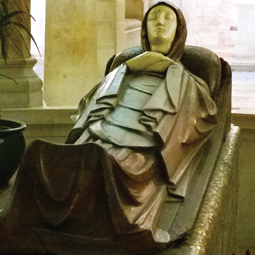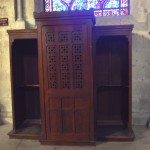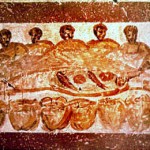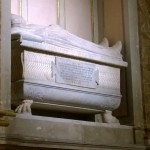On August 15, the Catholic Church celebrates the Solemnity of the Assumption of Mary – the day on which the Church commemorates Mary having been taken up, body and soul into heaven at the end of her life.
That can be tough for some folks to grasp. How do we know that Mary was assumed into heaven?
Life-size statue of Mary in the Church of the Dormition, Jerusalem. Photo by Marge Fenelon
Since Apostolic times, the “Tomb of Mary” had been a sacred place close to Mount Zion. On the hill itself is a spot marked as the “Dormition of Mary” (or the “Falling Asleep of Mary”), in keeping with the belief that Mary was assumed into heaven.
This was clarified at the Council of Chalcedon in 451, when bishops from throughout the Mediterranean world gathered in Constantinople. Emperor Marcian requested that the Patriarch of Jerusalem bring the relics of Mary to Constantinople so that they could be enshrined in the capitol.
But there were no relics.
The patriarch explained to the emperor that there were no relics of Mary in Jerusalem, that “Mary had died in the presence of the apostles; but her tomb, when opened later . . . was found empty and so the apostles concluded that the body was taken up into heaven.”
How is that possible?
Basically, the Catholic belief in the Assumption rests on this: The Assumption completes God’s work in Mary since it was not fitting that the flesh that had given life to God himself should ever undergo corruption.
Jesus lived in Mary’s womb for nine months. She nursed him, cared for him, bathed him, cuddled him, feed him, taught him, and followed him to the Cross.
Because she bore Christ, Mary’s body is completely holy.
That belief has been carried down through the centuries and it officially proclaimed doctrine on November 1, 1950.
On that day, Pope Pius XII announced the Apostolic Constitution, MUNIFICENTISSIMUS DEUS, defining the doctrine of the Assumption. Speaking to a jubilant crowd of more than 500,000 people packed into St. Peter’s Square, Pope Pius XII proclaimed, “Immaculate Mother of God, the ever-virgin Mary, having completed the course of her earthly life, was assumed body and soul into heavenly glory.”
Here’s how it’s explained in the Catechism of the Catholic Church: “Finally the Immaculate Virgin, preserved free from all stain of original sin, when the course of her earthly life was finished, was taken up body and soul into heavenly glory, and exalted by the Lord as Queen over all things, so that she might be the more fully conformed to her Son, the Lord of lords and conqueror of sin and death.” The Assumption of the Blessed Virgin is a singular participation in her Son’s Resurrection and an anticipation of the resurrection of other Christians: In giving birth you kept your virginity; in your Dormition you did not leave the world, O Mother of God, but were joined to the source of Life. You conceived the living God and, by your prayers, will deliver our souls from death. (Byzantine Liturgy, Troparion, Feast of the Dormition, August 15th)” (CCC 966)
Because Mary was assumed body and soul into heaven, she left no relics behind for us to venerate.
I love the way St. John Damascene summarized this tough-to-understand doctrine:
Although the body was duly buried, it did not remain in the state of death, neither was it dissolved by decay. . . . You were transferred to your heavenly home, O Lady, Queen and Mother of God in truth.
No, there are no relics of Mary. Instead, we have something more. We have her, available to us at all times, all places, and in all circumstances. She continues the work she began on earth – being mother to us – now from heaven.
St. Bernard of Clairvaux said it so beautifully:
And with regard to ourselves, how deservedly do we keep the feast of the Assumption with all solemnity. What reasons for rejoicing, what motives for exultation have we on this most beautiful day! The presence of Mary illumines the entire world so that even the holy city above has now a more dazzling splendor from the light of this virginal Lamp. With good reason thanksgiving and the voice of praise resound today throughout the courts of Heaven…let us not complain for here we do not have a lasting city, but we seek one that is to come, the same which the blessed Mary entered today.












